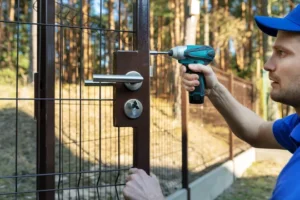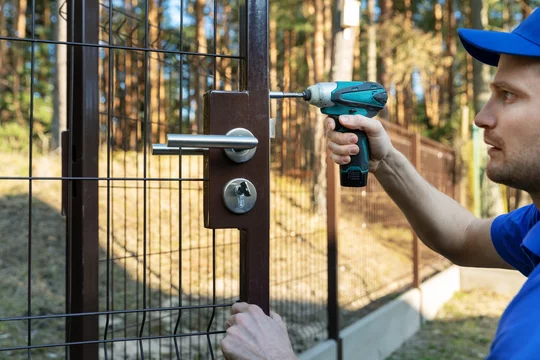Before starting to install a metal fence, contact 811 to have all buried utility lines marked. Also, check with the local zoning department to determine whether your chosen type of fencing is allowed on your property. Prepare the work area by clearing and digging post holes. Also, sort all of your tools and hardware ahead of time.
 Many factors can influence the cost of metal fence installation. The most significant factor is the style of fence you choose and how much length you need. In addition, you will need to consider the number and type of gates you want to include in your design. The terrain where the fence will be installed can also significantly impact the project’s cost. If the land needs to be leveled or graded, it can add up to a significant amount of extra money.
Many factors can influence the cost of metal fence installation. The most significant factor is the style of fence you choose and how much length you need. In addition, you will need to consider the number and type of gates you want to include in your design. The terrain where the fence will be installed can also significantly impact the project’s cost. If the land needs to be leveled or graded, it can add up to a significant amount of extra money.
Fences are usually priced on a per linear foot basis, so you should first calculate how many linear feet of fencing you will need. Then you can determine the materials and labor you will need to purchase.
A wood fence is usually the cheapest option, while vinyl costs about $13 per square foot. Aluminum and wrought iron are more expensive choices that offer increased durability and classic style. On the other hand, steel fences are more durable than other metals and can last up to eight times longer than wood. Corten steel has the added benefit of standing up to corrosion better than other types of steel. Prices for this type of steel fence run from $10 to $15 per linear foot.
In order to keep animals and children from climbing the fence, you can install fence caps that are welded onto the top of the bars. This simple modification will prevent children and pets from getting stuck between the bars and can be welded on for about $1.00 each. Another safety measure is to have a welder splice the ends of any exposed metal spikes to make them less of a hazard.
Other costs that should be considered are permits, excavation charges, and the cost of installing gates. It is always a good idea to check with your local planning and zoning office or wherever building permits are issued in your area before beginning the project. A permit will typically cost $25 to $50. Before digging, it is also a good idea to contact 811 and have your utility lines marked before drilling into the ground.
Whether to mark property lines or keep animals and children in or out of gardens, lawns and pools, metal fences are strong and durable. Popular styles include steel, aluminum, cable (chain link) and wrought iron. Steel is the strongest, and wrought iron offers a classic look that is both decorative and rust-resistant. Metal fencing is also available in a range of colors.
The cost of metal fencing depends on the type and style, and how much material is needed. Most fencing is measured in linear feet, with gate and post costs additional. The number of gates and their size are also important factors in calculating the total installation cost.
A 4-foot-tall prefab panel of tubular aluminum that’s held together with screws runs $10 to $14 per linear foot at home centers and fence suppliers. At about 11 pounds each, these panels can be “racked” to follow the slope of a yard or garden. Panels come with welded finials, fixed picket tops or screw-in tops (the latter are less expensive). Solid steel and hollow-aluminum fences are stronger but harder to transport, in 8-foot sections that require more posts.
Galvanizing—dipping iron into a zinc bath to seal it against rust—adds $2 to $4 per foot to the price of fence materials. But this upfront expense reduces maintenance and repair bills down the road.
For a more custom look, consider a powder-coated metal fence. This coating resists corrosion and doesn’t need periodic repainting like other metals do. The color will last for years to come.
A good fence contractor will survey the site to determine the best location and configuration for posts and panels. They should consider the terrain, such as slopes and soil composition, and the local weather conditions. For instance, wind can cause a loose fence to become dangerously unstable. In addition, they should consider the potential for flooding and other environmental hazards. They’ll also need to determine if the site requires bracing and trussing. If they do, this will increase the overall project cost. If not, it will reduce the amount of concrete needed to support the posts.
There are many different kinds of metal fences, and each one has its own advantages and disadvantages. Some offer added privacy and security, while others are used for decoration or to keep pets or children contained. While some styles require professional installation, most are fairly easy to install yourself. First, prepare the area for fence installation by ensuring that it is even and level and that it drains well. The soil may need to be amended with gravel or rock fill, and you should also check for underground power lines before starting. Once the area is ready, you can begin unboxing the fence materials and setting posts.
The most popular kinds of metal fencing are aluminum and traditional steel. These are both lightweight, which makes them less expensive than solid iron or wrought iron. They are also rust-resistant, meaning that you won’t need to worry about maintenance and repair as you would with other types of metal fencing.
Both aluminum and steel fences can be purchased in kits that include everything you need to assemble them. Most of these kits will come with end, corner and line posts and enough panels to enclose a given area. The cost of these kits varies widely, and it’s important to buy enough material to cover the area you plan on fencing.
Before you start installing the actual fence, dig post holes at least two feet deep. Make sure that the holes are plumb by restretching a guide string from one side to the other of the yard and then checking the alignment visually. If necessary, you can use a post hole digger or spud bar to make the bottom of the hole larger than the top and further anchor the concrete footer.
Once the posts are in place, you can begin connecting the panels. A common system uses universal metal brackets that slip over the top of each fence post and hold the panels in place with a carriage bolt. Once all the brackets are connected to the posts, tighten them with a hex wrench.
If you’re installing a chain link fence, add straining bars to the back of each post to provide stability. When all the line posts are installed and connected to the panels, you can begin laying the mesh, taking care to leave an even 2-inch gap between each row of mesh.
Metal fencing is a great option for homeowners looking to add security and privacy to their property. It is also relatively long-lasting and requires little maintenance compared to wood fences. However, it is important to regularly clean and inspect the fence for damage. If necessary, repairs should be made promptly to prevent further deterioration.
Generally, steel, aluminum, and wrought iron are the most common types of metal used for fencing. Each type of metal has its own advantages and disadvantages. For example, wrought iron is prone to rust, while aluminum and galvanized steel are resistant. If the fence has extensive rust damage, it will need to be sanded and repainted. For this reason, it is best to hire a professional to perform these tasks.
Cleaning a metal fence is simple and can be done on a regular basis. Use warm soapy water and a toothbrush or soft-bristled brush to scrub the entire surface of the fence. Rinse it thoroughly and let it dry. This will remove dirt, salt, and other debris that can cause corrosion. It is also a good time to check for loose or missing hardware components and tighten them.
The first thing to look for is rust. Wrought iron and other metals are prone to rust, so it’s important to check them regularly. Use a wire brush or sandpaper to scrub away any rust spots and re-paint them with a rust-resistant paint. It’s also a good idea to re-apply a metal sealant to the fence to help protect it from the elements.
Lastly, it’s important to keep the fence free from vines and other plants that may scratch or otherwise damage the iron. Using a garden hose to clear away the plant can be helpful, as can removing it from the fence altogether if possible. In addition, a layer of gel-based car wax can protect the wrought iron from moisture and oxygen, so it doesn’t oxidize as quickly.
If you’re unsure about whether or not to install a metal fence, contact your local home improvement store or fence installers. Many of them have showrooms where you can try different styles and materials and get technical advice from experts. They can help you decide what kind of fence is best for your home, and they’ll even pull the permits for you if you need them.
